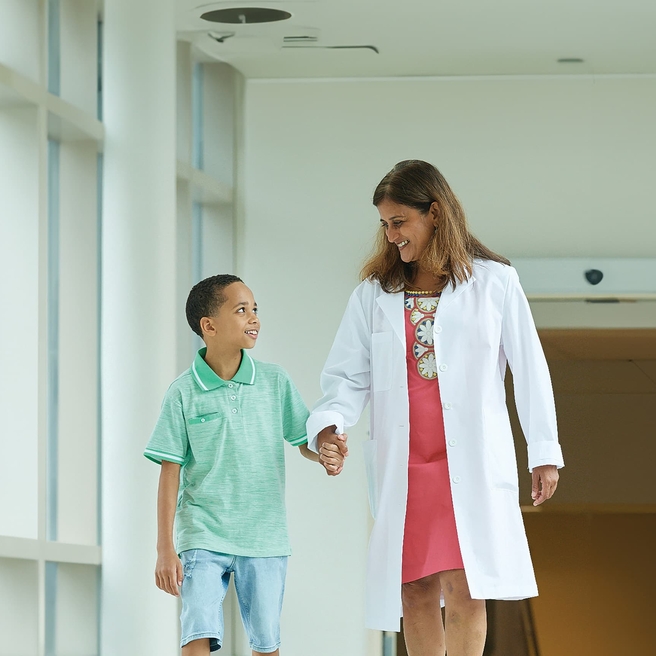What is a ventricular septal defect?
A ventricular septal defect (VSD) is an opening in the tissue (the septum) between the heart's lower chambers (the ventricles). A VSD is one of the congenital heart diseases referred to as "a hole in the heart."
When the VSD is large, the heart may have to pump harder to deliver enough oxygen to the body. Patients with a small VSD usually do not have any symptoms.
Sometimes children with a VSD also have other heart abnormalities.

Signs and symptoms of ventricular septal defects
If the hole is large, a child with a ventricular septal defect might exhibit symptoms including:
- Rapid heartbeat
- Difficulty feeding
- Heart murmur: the heart sounds abnormal when a doctor listens with a stethoscope
Testing and diagnosis for VSDs
A VSD might be diagnosed before your baby's birth using fetal echocardiogram. In this case, our Fetal Heart Program will prepare a plan for care after birth.
A VSD can also be diagnosed soon after birth. Your baby may exhibit symptoms or your doctor might notice a heart murmur . Sometimes, a VSD isn't diagnosed until your child is older.
Diagnosis of a ventricular septal defect may require some or all of these tests:
- Echocardiogram (also called "echo" or ultrasound): sound waves create an image of the heart
- Electrocardiogram (ECG or EKG): a record of the electrical activity of the heart
- Chest X-ray
- Cardiac catheterization : a thin tube (catheter) is inserted into the heart through a large vein in the leg
- Cardiac MRI : a three-dimensional image that shows the heart's abnormalities
It's important that a VSD be diagnosed and treated as needed, or the heart and the arteries between the heart and lungs might become damaged.
Treatment for ventricular septal defect
Treatment for a ventricular septal defect will depend on your child's health and on the size of the VSD. Doctors may wait to see if the VSD will close on its own. Many small VSDs will do so before your child is 2 years old.
If your child's VSD requires surgery, his doctors might wait until he is older and stronger. Until he's ready for surgery, your child may have to take medicines as well as have higher-calorie feedings to help with the symptoms.
During surgery to repair a VSD, a cardiothoracic surgeon will place a patch or stitches to close the hole during open heart surgery. CHOP's surgeons are among the most experienced in the nation in VSD closure.
In special cases, ventricular septal defects can be closed during a cardiac catheterization. During this procedure, an interventional cardiologist will insert a thin tube (catheter) through a vein and/or artery in the leg, then guide it to the heart. A device is then inserted to close the VSD. This is typically done using both ultrasound (echo) and x-ray guidance to ensure appropriate device positioning and stability.

Outlook for VSDs
Because of enormous strides in medicine and technology, today most children with heart conditions go on to lead healthy, productive lives.
Follow-up care for VSDs
Through age 18
After a VSD repair, many children recover quickly and won't experience additional cardiac problems. They must see a pediatric cardiologist for checkups, and some remain on medicine. Rarely, additional surgery is required.
Into adulthood
It's important that adults who were born with a VSD continue to see a cardiologist. We will help patients transition care to an adult cardiologist when the time comes.
The Philadelphia Adult Congenital Heart Center, a joint program of Children's Hospital of Philadelphia and Penn Medicine, meets the unique needs of adults who were born with heart defects.

Why Choose Us
Our specialists are leading the way in the diagnosis, treatment, and research of congenital and acquired heart conditions.
Resources to help
Cardiac Center Resources
We know that caring for a child with a heart condition can be stressful. To help you find answers to your questions – either before or after visiting the Cardiac Center – we’ve created this list of educational health resources.


